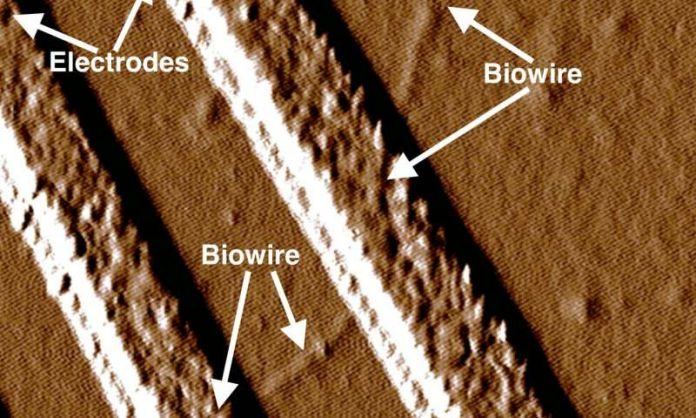Scientists from Office of Naval Research (ONR) creates electrical nanowires by inherently modifying common soil bacteria. The wire is thousand times thinner than a human hair and also capable of conducting electricity. The research was held at the University of Massachusetts Amherst.
The nanowires made up of non-toxic, natural proteins. It also avoids harsh chemical processes typically used to create nanoelectronic materials. According to scientists, it can be produce using renewable green energy resources like solar energy, carbon dioxide or plant waste. The material is developed to fulfill the increasing demand for smaller, more powerful computing devices. Producing thin wires through viable materials has huge potential applications. For example, in sensors, transistors, and capacitors.
Geobacter from soil bacteria enables wires to establish electrical connection with iron oxides that support its growth in the ground. Geobacter is a bacteria that produces microbial nanowires and naturally, contains enough electricity for its own survival. Although, the current is too weak for human use, but is enough to be measured with electrodes.
Scientists adjust the bacteria’s natural creation to change two amino acids naturally present in the wires with tryptophan. Tryptophan blamed for the sleepiness that results from too much Thanksgiving turkey. At nanoscale level, tryptophan is actually very good at transporting electrons.
Dr. Derek Lovley, said “We learn a lot about working of microbial nanowires. we realized it might be possible to improve on nature’s design. We rearranged the amino acids to produce a synthetic nanowire that we thought might be more conductive. We hoped that Geobacter might still form nanowires and double their conductivity.”
As a result, the electrical nanowires was 2000 times more conductive than their natural counterparts. With a diameter of 1.5 nanometers, they are also more durable and smaller. It means, thousands of nanowires could possibly store in the tiniest spaces.
Applications of Electrical Nanowires:
According to scientists, these ultra-miniature nanowires have numerous potential applications. For example, in electronic and computing devices continue to shrink in size. They could be install in medical sensors, where their sensitivity to pH changes can monitor heart rate or kidney function.
From a military perspective, the nanowires could feed electrical currents to specially engineered microbes to create butanol, an alternative fuel. This would be particularly useful in remote locations like Afghanistan, where fuel convoys often attacked and it costs hundreds of dollars per gallon to ship fuel to warfighters.
It also may play a critical role in powering highly sensitive microbes.
Lovley said, “This is an exciting time to be on the cutting edge of creating new types of electronics materials. The fact that we can do this with sustainable, renewable materials makes it even more rewarding.”
Also Read:
